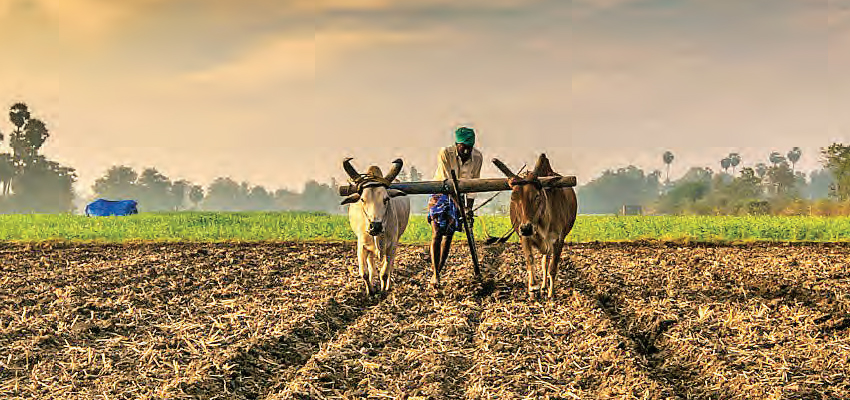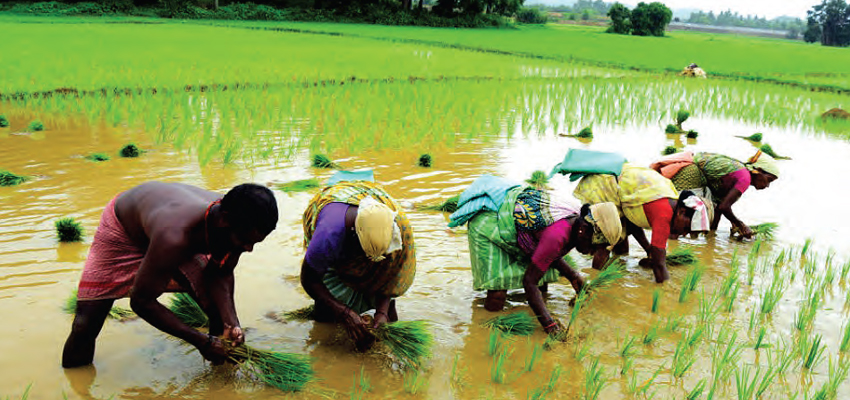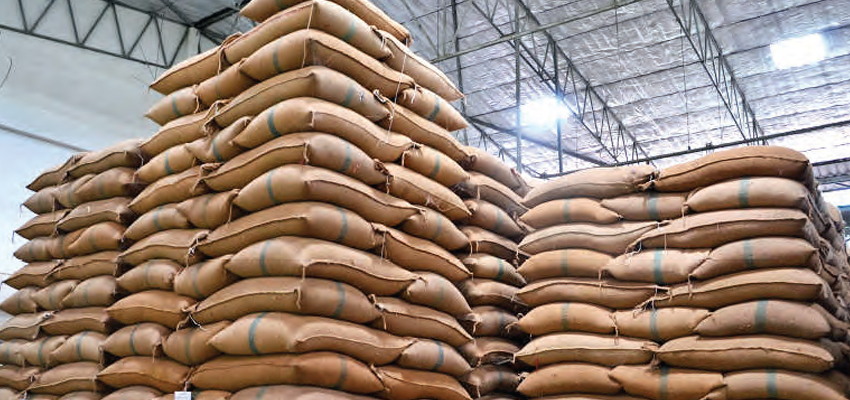The Future of Farming!

India is the land of agriculture. Farming accounts for 42% of the total employment of the country. For generations, farming in India has been more or less static. But with the advent of technology and the smartphone revolution, we are seeing some remarkable breakthroughs in the way farmers do business. One such company is ERGOS, which has revolutionised farm produce marketing by conceptualising a Grainbank that enables farmers to convert their grains into tradable digital assets, avail credit against those assets through partner NBFCs and Banks, and get better prices for their produce. To explain this incredible new concept and to highlight the fact that every problem has a solution, Ashutosh Kumar Sinha, Business Head, ERGOS India, spoke at a marketing symposium at a leading University. Corporate Citizen brings you this riveting conversation
 Ashutosh Kumar Sinha
Ashutosh Kumar SinhaWhat is innovation?
I feel that the word innovation is so innovative that anyone can define it in whichever way they want. This is what we at ERGOS do. We tell farmers that “let’s deposit some grain in the bank”. But how is this possible? We have a grainbank. Farmers produce grains and then these grains are sold. What we doing is creating banks for the grain. You might ask why we call it a bank and not a warehouse. That is because warehousing is a space rental business. You take some space, which takes a certain amount of grains, and you store grains. This is warehousing. But warehousing doesn’t solve the problem that farmers have. Farmers don’t have the minimum lot size for warehousing, which can go from 3 tonne to 100 tonnnes, depending on the requirement. So what do you do in a bank? You go and deposit a certain amount, say Rs 1000, in five Rs 200 notes. When you want to take it back, you will get your Rs 1000, but not the same notes. You’ll probably get some other denomination of currency, albeit for the same amount. What remains intact is value. The instrument changes. That’s what banking is about, and that’s the innovation in our model.
The Business Model
When farmers bring in their grain, it becomes fungible, it becomes interchangeable. Suddenly, when you think like that, even a small farmer who wants to bring a small bag of grain, can bring it to us, and we can digitise that grain. What that means is that the bag of grain, after checking its quality, is allotted the going price of the day for that particular crop. The digitised value is immediately entered into our mobile app which the farmer can access on his mobile phone. Now that grain is mixed with the same grain brought in by other farmers, and it loses its linked identity with the farmer who initially brought it in. This allows us to aggregate without linking it to individual farmers. If the farmer deposited his crop for the going rate of Rs 1500, he can track how much the going rate fluctuates daily using his app. If the going rate becomes, for example, Rs 1550, and the farmer wants to sell it for a profit, he can do that. This makes the grain a completely credible digitised asset. If I can draw a comparison, it is like trading in the share market. This, in a nutshell, is our business model. This benefits small farmers especially.
"If the farmer deposited his crop for the going rate of Rs 1500, he can track how much the going rate fluctuates daily using his app. If the going rate becomes, for example, Rs 1550, and the farmer wants to sell it for a profit, he can do that"

A series of innovations
Most small farmers do not have the minimum lot size to go to the warehousing. If they go to a warehouse, they will be told to bring in at least 3 tonnes of crop. Small farmers don’t have this much produce. Secondly, warehouses aren’t easily available. The second innovation we have brought in is how to operate small warehouses. Normal grain warehouses will be anything from 1000-100,000 ton capacity.
When you have bigger warehouses, you have to come closer to the market, and these are around 50 km from villages, so transportation is costly. If you want to go to the villages, you will need smaller warehouses, otherwise you’ll not have enough materials to fill it up. Our warehouses can house between 500-2000 tonnes. On average, the capacity of 800 tonnes. No warehouse company anywhere in the world can say that they can operate 500-700 tonne warehouses profitably. Most of them are lying vacant, because its difficult to operate those warehouses profitably and fulfil all the statutory requirements. That is another innovation which we have brought. We have created an organisational structure where we have a person called village champion. We call our model a relationship model. This infrastructure is created close to the farmhouse, where the farmer can bring in his produce on bullock cart, cycle, or motorcycle. The person who is managing this is called the village champion. He goes and meets farmers. He builds a relationship with them and makes a pitch. The village champion in combination to the warehouse being in the village brings about a sort of social security for all involved. We have never had a security issue despite never having a security guard to guard the produce. If you ask anyone in the warehousing industry whether you can operate a warehouse without a security guard, they will say it’s impossible and that you won’t even be given a licence to operate without it. But we have been able to work with the government to allow the registration without a security guard. There has to be a lot of leg work which we have to do to make this work, but I am proud that we have been able to do that. This is innovation on the infrastructure front.
Technological intervention
The third part is that because the warehouses are spread across distant places, there is a control issue. We call ourselves an agritech company. We have invested a lot of money, not just on this platform, but also on warehousing management. Some of the warehouses which we have created as model warehouses have almost been completely automated. We are using AI, RFID and IoT to keep track of each bag of grain. We are inserting a small IoT device in each bag which can track how the grain’s health is, how its moisture content is, how its carbon-di-oxide content is, and how its fungal content is. This allows us to maintain the quality of the grain. That’s the technological intervention that is happening. This has to be done because the grain is sold to the market and when we tell farmers to come to us and participate directly in the market as they might get a better return, we need to connect to larger buyers. For that, we need certificates such as the health report of the crop, and transparent quality reports. This created trust between all the parties. If you look at the impact, farmers have earned on an average 25-30% extra income. This is because farmers are able to earn a better price when the market is up, and they have been able to stop losses which they may have incurred if they would have stored the grains between their houses. So that’s what we are trying to do. We are trying to create an infrastructure and system where farmers and buyers can participate directly and transparently, have a warehousing solution which is created as per the best scientific methods, and have complete transparency. This is what is working.
Behavioural change in farmers
But to my mind, the biggest change that companies like ERGOS can bring in is to change some of the behavioural patterns in farmers post-harvest. Farmers are producers. Once they have harvested, they feel that they have done enough risk taking, having produced the grain weathering bad weather, rains, heat, and pests. They don’t feel like taking any more risk and want to sell off their produce as soon as possible. So they do it because they need money as they have taken a lot of loans. We provide them with loans as we have a lie up with various banks. If you look at the normal interest rate for the informal sector in villages, it will be between 1-3% a month. So that’s around 24-36% interest per year. We provide interest at the bank rate, which is 12% so people need not sell in desperation. If they need money, they can get it from us. The second thing is that farmers say that they don’t know how to trade. So we teach them how the prices move in the market. We advise them not to sell everything at one go. If you have put in 1 tonne into the grain brank, then don’t sell it off all at once. This is a bit like portfolio management services offered by banks. The third thing farmers keep saying that it is too much of a risk. We educate them about risk management. There is an entire shift in their behaviour because of this. We are turning farmers from just producers to a market participant or a trader. Which is why our tagline says “Mera Anaj Meri Punji”. This is what we have been trying to do. The traction has been pretty good till now. Our warehouses are maintained at the standard of any reputed warehousing company. We have been adding 40-50 warehouses every month. We have moved out of Bihar now. We are in Karnataka and Maharashtra today, and we will be soon going into other states. We hope that in 3 years time, we will be reaching out to 2 and a half million farmers with managing assets of grains worth Rs 8000-10000 crores. Considering farmers will be getting 25-30% extra benefit, they will be earning Rs 1600-2000. If that happens, we can say that we have created a business where the last person has the maximum benefit. Of course, every stakeholder will carry the responsibilities.
"Farmers say that they don’t know how to trade. So we teach them how the prices move in the market. We advise them not to sell everything at one go. If you have put in 1 tonne into the grain brank, then don’t sell it off all at once. This is a bit like portfolio management services offered by banks"

Origin of the idea
The idea for this unique concept was conceptualized by our co-founders Kishore Jha and Pravin Kumar. Kishore is a banker, and Pravin is an HR professional. They are both from Bihar, and they both worked in Bangalore. That’s how they came together. And since they both come from farming families, every time they met they would talk about it. It if from there that they got this idea, but it started from a place called Pusa. They started the business under a tree. They had a small thatched roofed house, one laptop and a lot of energy. That’s how the journey started.
Solving the problem
Let’s look at the core of the problem. There is a long value chain. When there are a lot of joints in the chain and if the material changes hands multiple times, the joint bleeds. All the companies, not just in farming but in any sector, are just trying to plug in those leaks. But how do we think in a newer way to plug those gaps? We know there are farmers producing the food, there is a market willing to buy, and there are many people in-between this chain. Our focus was whether we could connect them directly? Everyone said that we should do it. But when you look at the infrastructure part, how do you do it? When you look at the technology part, how do you do it? When you look at the behavioral part of the participants, how do you do it? Unless we look at the problem holistically, we will not be able to do everything ourselves. But one or two core things we can address. My advice is that when you look at any business or any job, loot at it holistically, and evaluate the best way to solve the problem, and believe me, there is always a way to do it.
Digital divide
A question often asked is about technological barriers and the digital literacy of farmers. Yes there are technological glitches sometimes. But these are not deal breakers. You can always figure out a solution. Most of the business is done by the mobile app. There are many people who don’t own a smartphone, so how do they do it? We have to figure out a work-around. We have the village champion, we use SMS, Phone Calls, we have people who can navigate the app on behalf of farmers, etc. Secondly, this barrier is vanishing so fast. We work in one of the most economically poorer parts of India and within the deepest villages in India. There also, we find that there is at least one smartphone in a home. The farmer himself may not be the one carrying it, but someone in the family would have it. In a way, there is a technological teacher in every family, usually from the younger generation. You won’t believe that the YouTube following of some of the folk singers from villages are into 3-4 million. Due to cheap data plans in India, these people are consuming a lot of digital content. It is developing so fast, that the technological divide is vanishing at the rate of 50-60% every year.